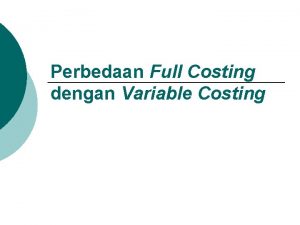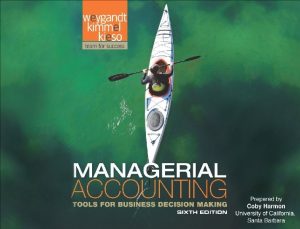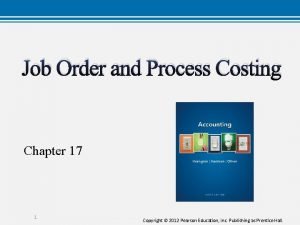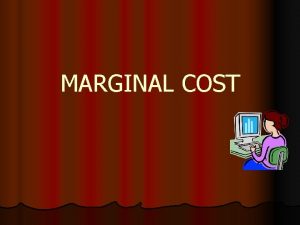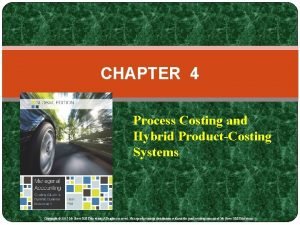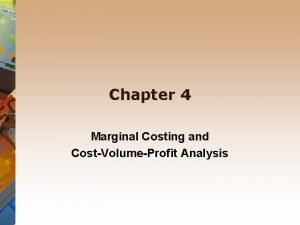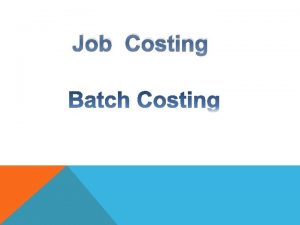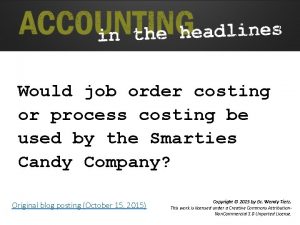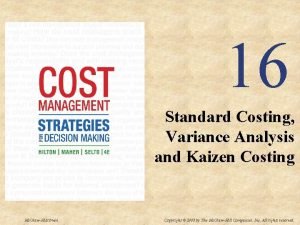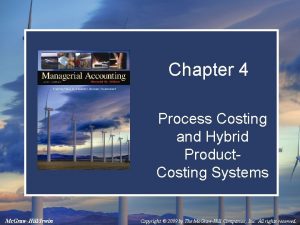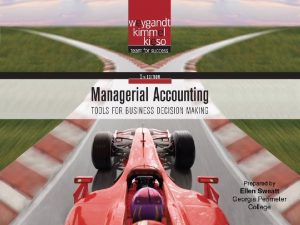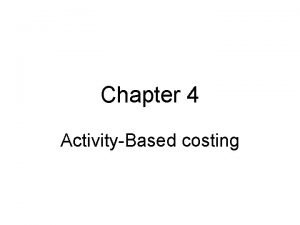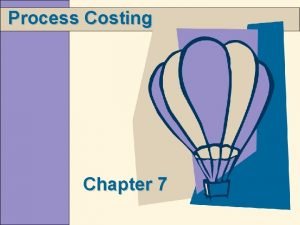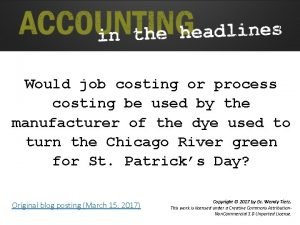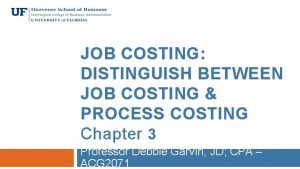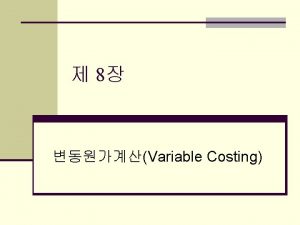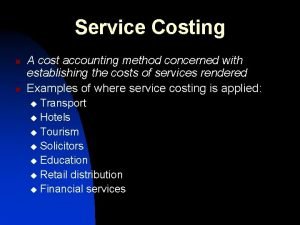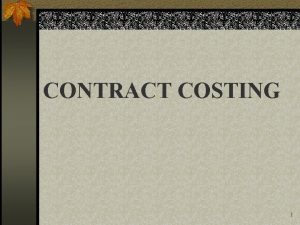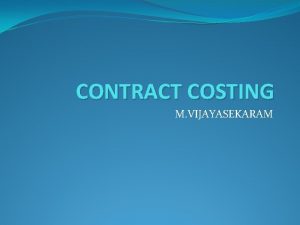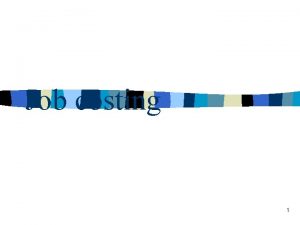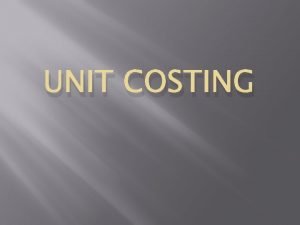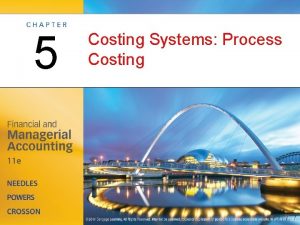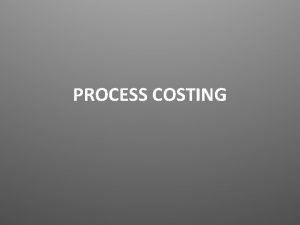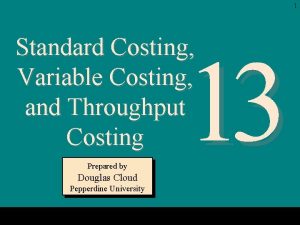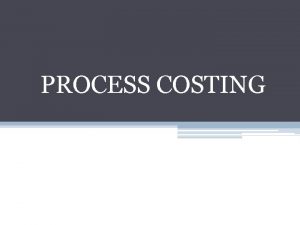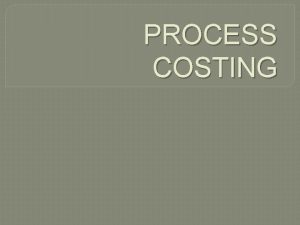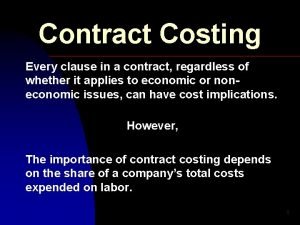CONTRACT COSTING I N T R O D





















- Slides: 21

CONTRACT COSTING

I N T R O D U C T I O N CONTRACT COSTING is a specialized system of job costing which applies to long-term contracts as distinct from short-term jobs. These Contracting business usually takes years to get completed to ascertain reasonable profits according to stage of completion of contract. Eg: Contract of Roads, Railway wagon, ship building, Building etc.

CIMA defines : CONTRACT COST AND CONTRACT COSTING as follows “Contract cost is the aggregated cost relative to a single contract designated a cost unit” “Contract costing is that form of specific order costing which applies where work is undertaken to customers special requirements and each order is of long-term duration”.

FEATURES LONG PERIOD DURATIONS CONSTRUCTION ACTIVITIES WORK IS DONE ON THE SITES UNDERTAKEN ON SPECIAL REQUIREMENTS OF CUSTOMER

ACCOUNTING TREATMENT OF COSTS Accounting of each item of cost in contract accounts is discussed below : 1. MATERIAL 2. LABOUR 3. PLANT 4. SUB-CONTRACT CHARGES 5. OVERHEADS

EXPLAINATION �MATERIALS a) All the materials purchased for the contract or any material sent to site is charged to contract. b) If any material is returned to stores or lying at site unused or materials transfers to another contract site is credited to the Contract Account. c) If materials are not required immediately, the materials may be stored and its costs is debited to Stock Account.

Labour All the labour employed or worked at site is treated as direct labour and all costs relating to them is charged to the Contract Account. The salaries and the incentives of the administrative and supervisory staff of a specific contract is also charged to that specific contract.

PLANT a) When the plant is taken on hire, the hire charges are charged to Contract Account. b) If the plant specially purchased for the contract or plant was sent to site, the value of the plant is debited to Contract Account. c) Sometimes the value of depreciation provided on the plant is debited to Contract Account instead of showing the value of plant issued it site and remaining at site.

Sub-contract charges Sometimes part of the contract work is given on sub contract basis and payments made on sub contract work is debited to Contract Account OVERHEADS The general overheads and head office expenses are apportioned to different contracts on equitable basis, and the portion of overheads are charged to Contract Account.

Certified and uncertified work In contract works a surveyor or an architect or civil engineer is appointed to periodically visit the site for inspection of the work completed. He will issue a certificate mentioning the stage of completion of work and the value of the work completed to the date of issue of certificate. The payments will be released to the contract or by the contractee based on the said certificate. Normally the payments will be released only to the certain percentage, say 80% of the work certified. The balance of the work certified is retained by the contractee till the completion of the entire contract satisfactorily. The amount so retained is called Retention money.

Ascertainment of Work-in-Progress The amount of work-in-progress includes the value of work certified and uncertified appearing in the Contract Account, the cost of work not completed, the amount of profit taken as credit.

RETENTION MONEY The contractor is always payed against the work completed and certified. But the contractee do not pay full amount but hold back certain amount of money as retention money which will only be paid after the whole work is completed. It is the buffer to contractee in case the contractor does not fulfill any condition of contract.

ESCALATION CLAUSE To safeguard against the fluctuations in prices of material and labour an escalation clause is added. This clause makes provision for increasing contract prive in event of certain contingencies. A DE-ESCALATION clause may also be added to the contract for any decrease in prices to pass the benefit to the contractee.

BALANCE SHEET AS ON 31 march. . Assets Rupees Work-in-progress Work certified xxx Work uncertified xxx Less: Amt rec. from Contractee xxx Less: Reserve for unrealised Profit xxx

It is necessary to determine profit to be attributed to each accounting period in long-term nature contracts. It is considered that their outcome can be assessed with reasonable certainty before their conclusion. The attributable profit should be calculated on a prudent basis and included in the accounts for the period under review. The profit taken up should be based on Standard Cost Accounting Principles. In case of Completed Contracts, all the profit that arise from the contract can be transferred to Profit and Loss Account. But in case of Incomplete Contracts, only that portion of profit is taken to Profit And Loss Account depending on the extent of work completed on the contract because some provision is to be made for meeting contingencies and unforeseen loss.

PRINCIPLES Ø If loss is arrived on incomplete contracts, the entire loss is debited to Profit And Loss Account. Ø Profit should be considered only in in respect of work certified. The uncertified work should be valued at cost. Ø Completion of contract is les than 25% of the contract price – No profit should be taken to Profit and Loss Account and the entire amount is kept as a reserve for meeting contingencies. Ø

Completion of contract is upto 25% or more, but less than 50% of the contract prices – In the case 1/3 rd of profit, reduced in the ratio of the cash received to work certified should be taken to the Profit and Loss Account. Thee balance will remain as reserve for meeting Contingencies. The formula is given below : Notional Profit x 1 x Cash Received 3 Work Certified Completion of contract is 50% or more, but less than 90%- In this case 2/3 rds of profit ascertained as reduced by proportion of cash received to work certified to be taken to Profit and Loss Account Notional Profit x 2 x Cash Received 3 Work Certified

Cost Plus Contracts Definition and Meaning : Cost Plus Contract is the contract in which the value of the contract is ascertained by adding a certain percentage of profit over the total cost of the work. CIMA defines cost plus contract as one where the contractor is reimbursed allowable or otherwise defined cost plus a percentage of these costs or fixed fee towards profit.

Features ü Cost of contract will be very high ü Period will last over considerable length of time exceefing one or more years ü Most contracts are executed at site, away from the office of contractor. ü Certain portion of main contract will always be sub contracted ü Expenses incurred by the contractor directly are considered as direct while office, stores etc are considered indirect expenses. ü Separate account is maintain foe separate contract. ü Progressive payments are received on basis of work certified. ü Certain amount of money is always kept reserve by contractee as retention money. ü Defective work is rectified at cost charged to contractor while extra work is charge to contractee if not provided in contract.

Advantages �Protected from fluctuations in prices, material, labour and services. �Assured of profits as per the terms of agreement. �Execution of work at reasonable cost is assured to the contractee. �Avoids delay and chances of error in estimation. � Avoids complex calculations. Disadvantages �No motivation to effect cost savings. �No clear idea of liability till the completion of entire work. �It may also lead to dissatisfaction for both the contractor and the customer. �Fails to reflect competition �Ignores demand �Inefficiency can also increase cost an losses.

Conclusion Contract costing is a form of specific cost of order. It is a specialized system of job costing for long term contracts are different from short term jobs. Long term contacts are adopted for accounting procedure & the recognition of profit in case of running contracts & contracts nearing completion were explained with the help of by giving various alternative formulas.
 Difference between job costing and contract costing
Difference between job costing and contract costing Perbedaan full costing dan variable costing
Perbedaan full costing dan variable costing Advantages of activity based costing
Advantages of activity based costing Job order costing vs process costing
Job order costing vs process costing Absorption costing vs marginal costing
Absorption costing vs marginal costing Cost production report
Cost production report Absorption costing vs marginal costing
Absorption costing vs marginal costing Job costing vs batch costing
Job costing vs batch costing Job order costing vs process costing
Job order costing vs process costing Kaizen costing vs standard costing
Kaizen costing vs standard costing Metode full costing dan variable costing
Metode full costing dan variable costing Job costing vs process costing examples
Job costing vs process costing examples Product costing
Product costing Activity based costing formula
Activity based costing formula Job wr53 at nw fab
Job wr53 at nw fab Chapter 4 activity-based costing solutions
Chapter 4 activity-based costing solutions Process costing and hybrid product-costing systems
Process costing and hybrid product-costing systems Job costing vs process costing
Job costing vs process costing Difference between job order costing and process costing
Difference between job order costing and process costing Mixed cost
Mixed cost Job costing with process costing
Job costing with process costing Difference between service costing and product costing
Difference between service costing and product costing

